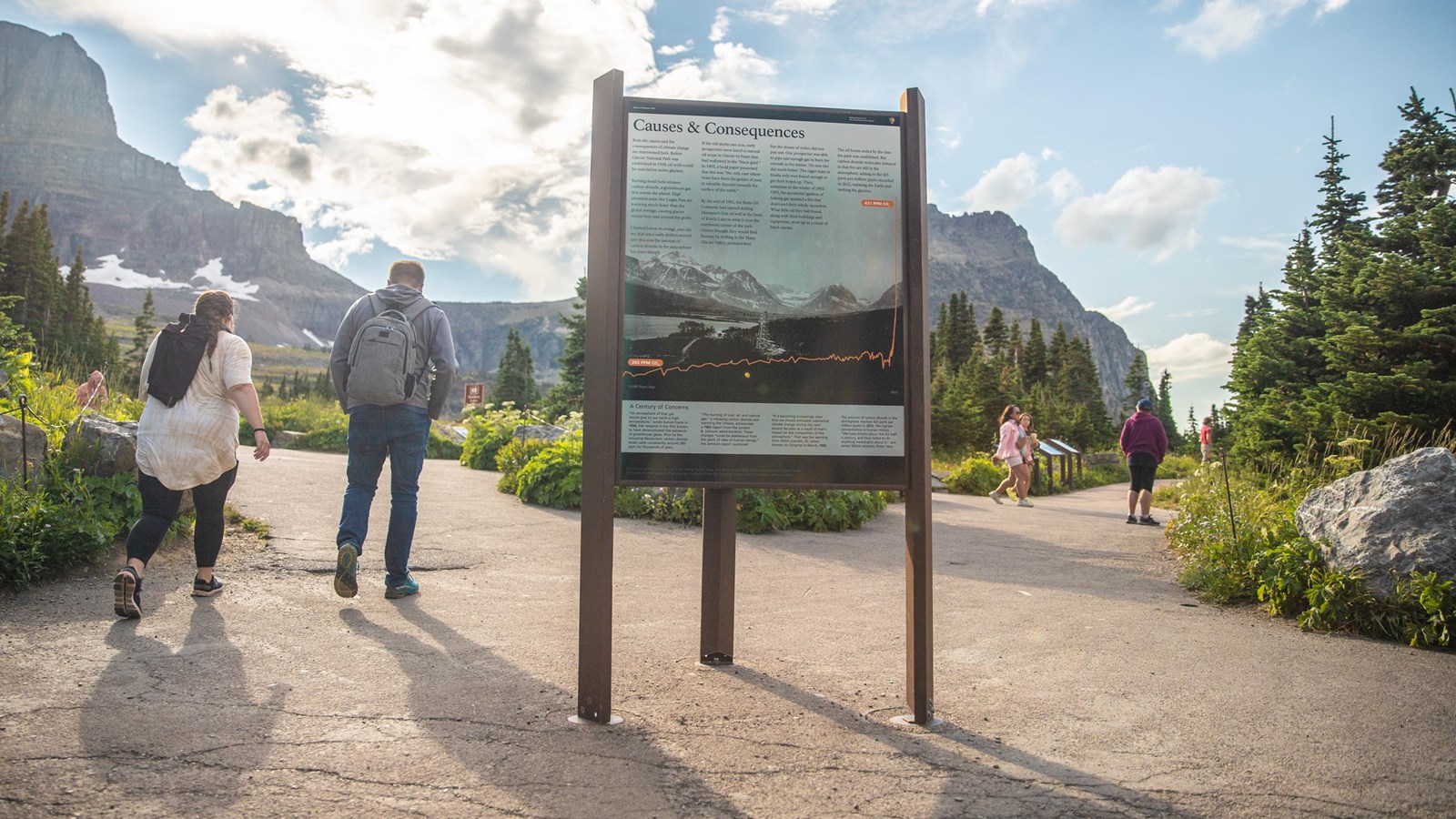Last updated: September 26, 2023
Place
Logan Pass Causes and Consequences Exhibit

Historical/Interpretive Information/Exhibits, Information, Information Kiosk/Bulletin Board, Wheelchair Accessible
Causes & Consequences
Both the causes and the consequences of climate change are intertwined here. Before Glacier National Park was established in 1910, oil wells could be seen below active glaciers.
Burning fossil fuels releases carbon dioxide, a greenhouse gas that warms the planet. High elevation areas like Logan Pass are warming much faster than the global average, causing glacier retreat here and around the globe.
Charted below in red, you can see that since early drillers moved into this area the amount of carbon dioxide in the atmosphere has risen sharply.
If the old stories are true, early prospectors were lured to natural oil seeps in Glacier by bears that had wallowed in the “black gold.” In 1892, a local paper presumed that this was “the only case where bears have been the guides of men to valuable deposits beneath the surface of the earth.”
By the end of 1901, the Butte Oil Company had started drilling Montana’s first oil well at the head of Kintla Lake in what is now the northwest corner of the park. Others thought they would find fortune by drilling in the Many Glacier Valley, pictured here.
But the dream of riches did not pan out. One prospector was able to pipe just enough gas to burn for warmth in the winter. No one else did much better. The eager team at Kintla only ever found enough to get their hopes up. Then, sometime in the winter of 1902-1903, the accidental ignition of leaking gas sparked a fire that destroyed their whole operation. What little oil they had found, along with their buildings and equipment, went up in a cloud of black smoke.
The oil boom ended by the time the park was established, but carbon dioxide molecules released in that fire are still in the atmosphere, adding to the 421 parts per million (ppm) recorded in 2022, warming the Earth and melting the glaciers.
A Century of Concerns
“An atmosphere of that gas would give to our earth a high temperature,” wrote Eunice Foote in 1856. Her research is the first known to have demonstrated the existence of greenhouse gases. Prior to the Industrial Revolution, carbon dioxide levels were consistently around 280 ppm for about 6,000 years.
“The burning of coal, oil, and natural gas,” is releasing carbon dioxide and warming the climate, announced a 1965 report from the Lyndon B. Johnson administration. These changes “could be deleterious from the point of view of human beings,” the Johnson report cautioned.
“It is becoming increasingly clear that we should anticipate substantial climate change during the next several decades as a result of man’s impact on the composition of the atmosphere.” That was the warning from NASA scientist, Dr. James Hansen to Congress in March, 1982.
The amount of carbon dioxide in the atmosphere reached 421 parts per million (ppm) in 2022, the highest concentration in human history. “We have known about this for half a century, and have failed to do anything meaningful about it,” said senior NOAA scientist, Pieter Tans.
Solutions & Benefits
How did you get here? It’s likely that burning fossil fuels was your only choice for traveling to Logan Pass. That is how it’s been for most visitors since Going-to-the-Sun Road first opened in 1933. For over a century, fossil fuels have taken us anywhere we wanted to go.
Though unintended, burning these fuels releases greenhouse gases that warm the climate. Limiting this warming requires shifting away from fossil fuels. Besides mitigating climate change, there are many other benefits to this transition.
Electric vehicles and appliances powered by renewable energy are more efficient, quieter, and safer. Fossil fuels may have been your only choice today, but alternatives—and their side benefits—are quickly becoming widespread.
For these reasons and more, Glacier National Park has already begun an effort to reduce its reliance on fossil fuels, lowering its greenhouse gas emissions. From remote areas like Polebridge and Goat Haunt to busy hubs like the Apgar Visitor Center and park headquarters, Glacier is transitioning to renewable sources of energy.
The Logan Pass Visitor Center showcases these efforts. Open during the sunny summer months, this area obtains all of its electricity from solar panels—a model of sustainability.
